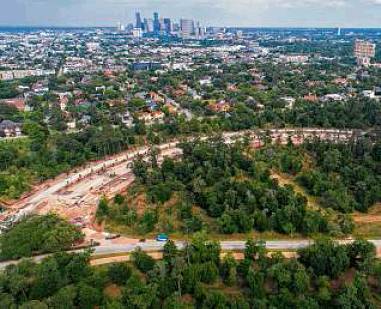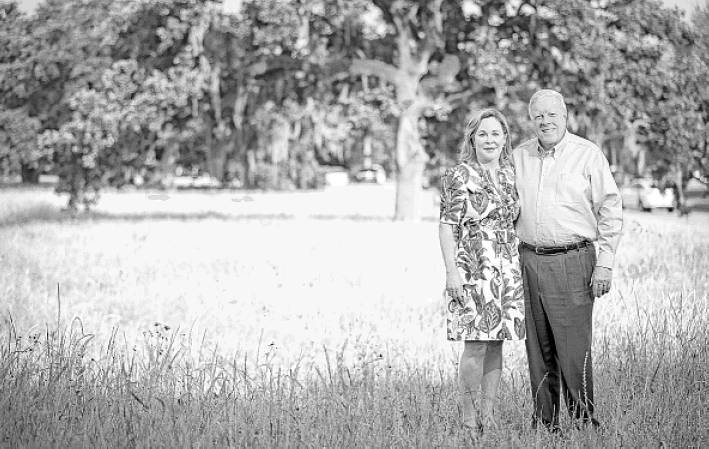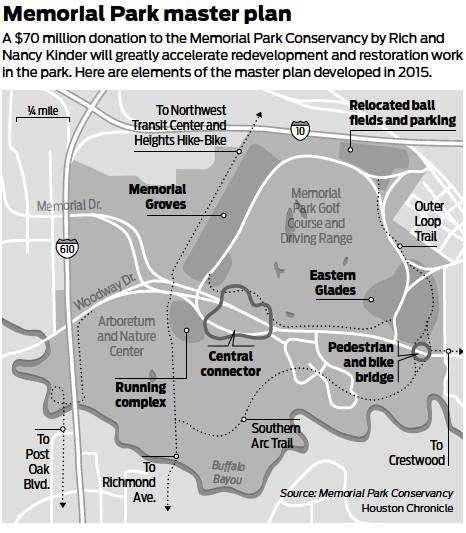Kinders give $70M to Memorial Park
Grant offer would fast-track projects in plan to create top urban greenspace
By Molly Glentzer
Super-philanthropists Nancy and Rich Kinder, who have led Houston’s drive to become the nation’s most green-forward city for more than a decade, have dropped another big kiss on the landscape they love.
With a vision of creating the best urban park in America during their lifetimes, they have offered a $70 million grant to the Memorial Park Conservancy to fast-track redevelopment projects that are major components of a master plan approved by City Council in 2015.
Mayor Sylvester Turner announced the offer for the largest greenspace donation in Houston’s history on Wednesday before the conservancy presented a revised development agreement to the council’s quality of life committee. The agreement outlines a private-public funding network for developing a significant portion of the master plan within the next decade, which will be submitted to the full council next week for a vote.
By now, such public-private partnerships are familiar to many Houstonians. They are a requirement of the Kinder Foundation’s lead gifts for major projects, Rich Kinder said.
The Memorial Park Conservancy, the Uptown Development Authority and the city’s parks and recreation department are implementing the plan, but the Kinders are not the type of donors who write checks and walk away. They are active participants, also setting up a standards committee that oversees the management of projects and ensures that investments will be maintained for years to come.
$106 million already given
The new grant offer adds significantly to the couple’s already impressive parks legacy of $106 million in donations. Their past lead gifts have helped to create such landmark successes as Discovery Green, Buffalo Bayou Park and the ongoing Bayou Greenways 2020, along with numerous smaller projects — usually executed through public-private partnerships between the city’s parks and recreation department, management districts and conservancies.
“We’ve proven to them we’re good partners,” Nancy Kinder said.
The couple’s generosity has catapulted Houston into the national spotlight during the past decade as one of the most green-forward cities in America, and perhaps the world. They also have provided transformative gifts to the Museum of Fine Arts, Houston (where the Nancy and Rich Kinder Building for Modern and Contemporary Art is under construction) and schools.
“Colleagues in other cities are floored at how we’re advancing the public-private partnership model in sophisticated ways,” said Memorial Park Conservancy president and CEO Shellye Arnold, “and it’s really the Kinders spearheading that.”
To date, the conservancy has raised about $20 million. Arnold said the Kinders’ involvement will help the organization raise another $40 million in private funds to complete the master plan, also making it a stronger candidate for a $30 million federal grant that would support new connector paths into Memorial Park, which she said has been “an island in a growing sea of hike and bike trails across Houston.”
The redevelopment authority, through its TIRZ, has committed $50 million to the 10-year plan for infrastructure improvements including road, trail and drainage planning and construction.
Neighborhood parks across Houston will share a bit in the windfall: The partnership would release the city from annual obligations of $600,000 for park maintenance and the operation of the Cullen Running Trails Center, enabling the parks department to redistribute those assets across the city.
A ‘central connector’
The Kinders said their gift is “front-loaded” to achieve the biggest priorities of Memorial Park’s master plan first.
“It’s a real challenge to be better than Central Park, but I think we’re up for it,” Nancy Kinder said.
Along with completing the Eastern Glades, the major savannah restoration and five-acre lake project now underway east of the golf course, first up will be the development of the snazzy “land bridge” across Memorial Drive — a project whose audacious architecture caused a stir when it was first unveiled by the master plan’s designer, Nelson Byrd Woltz, several years ago.
The bridge, which could be finished in as little as five years, represents more than an architectural icon, Nancy Kinder said.
Now referred to as a portion of a major “central connector” that will reconnect the park’s long-divided north and south sectors, the project will also serve major ecological functions. The design incorporates flood retention and stormwater management as well as 50 acres of new prairie habitat across Memorial Drive.
“It’s what Houston asked for and science demanded,” Arnold said. “It’s about creating a more resilient Houston, not just habitat in the park — aconcept that underpins the entire master plan.”
The plan was initiated after Memorial Park, which is somewhat unique as both a major urban wilderness and a haven for recreational sports, lost more than 60 percent of its tree canopy to high winds from Hurricane Ike in 2008 and a subsequent major drought. Hurricane Harvey’s floods only amplified the need to create a healthier ecology, because native prairie and savannah greenspaces—unlike the overgrown forests that previously had covered the park’s original ecosystem — help retain and absorb water during flood events, Arnold said.
The central connector will heal a “75-year-old wound,” she added.
Rich Kinder concurred. Memorial Park’s founders, who sold the land to the city for a paltry sum in 1924, never envisioned the land split in two by a major thoroughfare such as Memorial Drive, he said. “We really have two separate parks there now, and it detracts from the overall ambiance.”
Sarah Newbery, the development authority’s Memorial Park project manager, sees the central connector as symbolic of “so much,” she said. “When we think in an integrated way, Houston can lead.”
The Kinders’ gift would also be used to create new trails within the park; relocate ball fields that will have new and improved facilities; build a running track at the running center south of Memorial Drive; and develop a Memorial Grove that highlights remnants of Houston’s unique military history.
“This park’s role in U.S. history is unique: It’s the only place that still has a remnant of the 17 emergency training camps that were built across the U.S. during World War I,” Arnold said. The grove’s tall pines will honor soldiers who died after serving in Houston’s camp, also reminding people how the park got its name.
If the conservancy wins federal funding, hike-and-bike trail connections will open Memorial Park to the White Oak Bayou trail, north across Intersate 10; south over Buffalo Bayou, toward Richmond Avenue; and west, under Loop 610 to the archery range and kayak launch area on Woodway. Arnold said the conservancy still hasn’t yet been able to find a way to connect Memorial Park and Buffalo Bayou Park.
She also expects park users to grouse about parking meters that will be installed near amenities. Because of its unique character, Memorial Park lacks the kind of event rental amenities that provide operating and maintenance at other major greenspaces, Arnold explained. The conservancy’s board saw an opportunity to ask users to contribute by paying to park.
“There will always also be free parking,” she said, “but we also want to encourage people to come on bike trails once they are open.”
‘Our goal is to give back’
Runners account for about 90 percent of the park’s daily users, who come from at least 172 zip codes, according to the conservancy. The MapMyRun smart phone app lists the park’s Seymour Lieberman Trail as the most popular of its top 20 running routes in the nation.
Joe Carey, who lives in the adjacent Camp Logan neighborhood, walks at least three times a week in the park. He likes what he sees happening with the master plan, even though he expects new amenities will bring an influx of more visitors.
“The activity doesn’t bother us at all,” he said. “Perhaps it will become a destination park for runners and walkers outside of Houston, like, for example, Central Park in New York or Hyde Park in London are.”
Carey also is a vice president for the Houston Area Road Runners Association, which supports the plan. He was happy to hear about the potential for new connector hike and bike trails, which are sorely needed.
Some residents of Crestwood, next to the Eastern Glades, remain angry about the removal of trees and dense underbrush that grew during the 20th century and once divided their subdivision from the park. That area is being restored as native savannah habitat, to make it more resilient.
Carey takes a long view. “One has to be careful to look at the big picture and not focus on a tree here, a change there,” he said. “It’s a holistic plan.”
Pretty much every weekend they are in town, the Kinders are out enjoying the city’s parks with everyone else. They often walk the Seymour Lieberman trail in Memorial Park or trails through Buffalo Bayou Park with their grandchildren and a trio of golden retrievers.
All of their work — the parks, the museum assets and schools — is about improving the quality of life in Houston for all, ultimately making the city attractive to a talented workforce, Rich Kinder said.
If they can do that, he added, “that’ll be a major accomplishment.”
And there’s more to come. “The organization can only handle so many projects at once, but we’re not finished yet,” Nancy Kinder said, describing a “secret yellow notepad” that still contains a list of future dream projects.
“We’ve been very fortunate here in Houston, and our goal is to give back,” Rich Kinder said. “Through our foundation, we intend to give away everything we have.” molly.glentzer@chron.com


